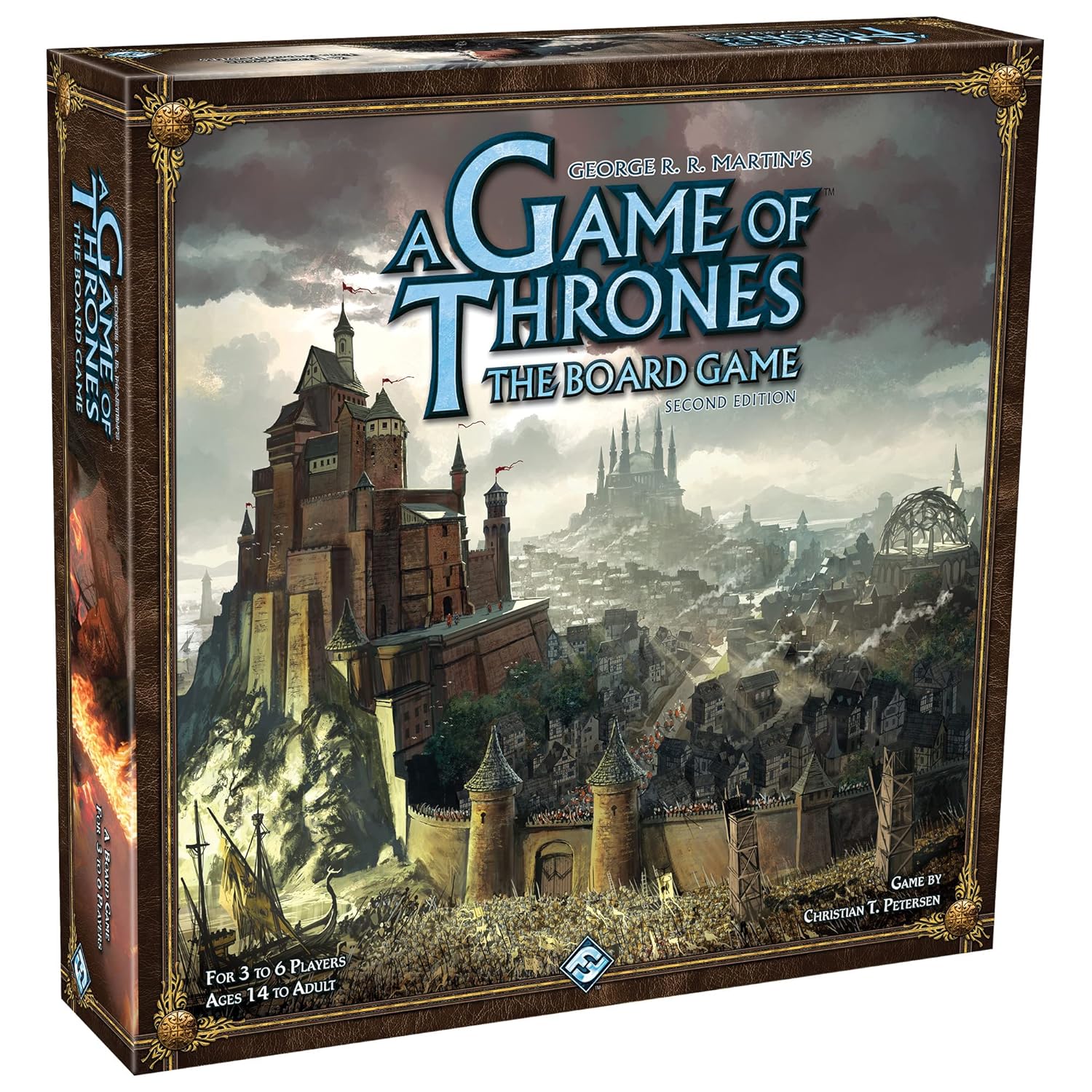A Game of Thrones (2003)
Brief History and Background Information of A Game of Thrones
A Game of Thrones is a strategy board game created by Christian T. Petersen and published by Fantasy Flight Games in 2003. The game is based on the A Song of Ice and Fire series of high fantasy novels by George R. R. Martin. It was followed in 2004 by the expansion A Clash of Kings, and in 2006 by the expansion A Storm of Swords.
Why is A Game of Thrones Popular?
The game is popular because it allows players to immerse themselves in the world of Westeros and control one of the great noble Houses: Lannister, Stark, Baratheon, Tyrell, or Greyjoy. With planning, diplomacy, and clever card play, players seek to control the most Strongholds and Cities to finally claim the Iron Throne for themselves and their House. The game is significant because it was ground-breaking for its combination of euro and American mechanics, and it influenced later Fantasy Flight Games board games that likewise profited from a “mixture of tight eurogame mechanics and deep American theming”.
Game Components of A Game of Thrones
– Game board
– House cards
– Order tokens
– Power tokens
– Influence tokens
– Neutral army pieces
– Westeros cards
– Wildling cards
– Victory point tokens
– Player screens
– Rulebook
Game Setup of A Game of Thrones
Each player selects a starting House, places starting units on the board as indicated by the instructions, places House markers on the Supply and three Influence tracks, and takes the hand of seven House characters to be used in battles.
Gameplay Mechanics of A Game of Thrones
The game is played on a board that divides the continent of Westeros into several regions. Most regions have at least one icon representing a city, a stronghold, a support barrel, or a power icon, and some key locations have multiples of such icons. Players use House cards to bid for turn order, and then take turns placing order tokens on the board. These tokens represent orders to muster armies, march them to different regions, defend against attacks, or support other players’ orders. Players can also play Westeros cards, which can have a variety of effects on the game, such as changing turn order, causing wildling attacks, or giving players extra power tokens. At the end of each turn, players collect power tokens based on the number of cities and strongholds they control, and can spend these tokens to bid for turn order in the next round. The game continues for ten rounds, and the player who controls the most cities and strongholds at the end of the game wins.
Game Objective of A Game of Thrones
The objective of the game is to control the most Cities and Strongholds on the game board by the end of the tenth round.
Player Experience
Players experience the game as a strategic and diplomatic struggle to claim the Iron Throne. They must use their House cards, order tokens, and power tokens wisely to outmaneuver their opponents and gain control of key regions. The game can be tense and competitive, with players vying for control of the same regions and trying to anticipate each other’s moves. However, it can also be a social game, with players forming alliances and negotiating deals to achieve their goals.
Variations and Expansions (if applicable)
The game has two expansions: A Clash of Kings and A Storm of Swords.
Conclusion
A Game of Thrones is a popular strategy board game that allows players to immerse themselves in the world of Westeros and control one of the great noble Houses. The game is significant for its combination of euro and American mechanics, and it has influenced later Fantasy Flight Games board games. The Game Components of A Game of Thrones include a game board, House cards, order tokens, power tokens, and more. The Game Objective of A Game of Thrones is to control the most Cities and Strongholds on the game board by the end of the tenth round. The game can be tense and competitive, but also social, with players forming alliances and negotiating deals. The game has two expansions and can be purchased online from various retailers.
Game Components of A Game of Thrones
How To Setup A Game of Thrones
To set up the game, each player selects a starting House and places the corresponding units on the board. Players position their House markers on the Supply and Influence tracks and take a hand of seven House character cards. The Westeros decks are shuffled and placed within view of all players. The player with the highest position on each Influence track receives special tokens such as the Iron Throne, Valyrian Steel Blade, and Messenger Raven.
Gameplay Mechanics and Game Objective
Gameplay Mechanics
Game Objective
Player Experience
Playing A Game of Thrones is an immersive experience that combines strategic planning, diplomacy, and tactical battles. Players must balance military expansion with managing their influence and resources. The game encourages strategic thinking and adaptability, as players need to adjust their plans based on the actions of their opponents and the draw of Westeros cards.
Pros
Cons
Personal Thoughts on A Game of Thrones
A Game of Thrones is ideal for fans of strategy board games and the A Song of Ice and Fire series. It offers a rich and engaging experience that requires careful planning and diplomacy. While it may be too complex for casual gamers, it is a must-play for those who enjoy deep strategic gameplay and the world of Westeros. With its numerous expansions and updates, it continues to evolve, providing a fresh experience with each playthrough.
We are supported by our audience. When you purchase through links on our site, we may earn an affiliate commission, at no extra cost for you. Learn more.

